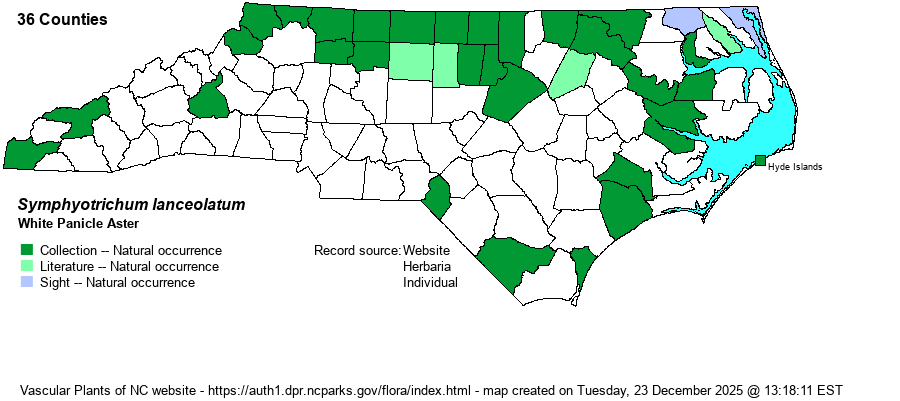| Author | (Willdenow) G.L. Nesom | |
| Distribution | Formerly named as Aster simplex in older references. Occurs in scattered locations from the low Mountains across the northern Piedmont to the Coastal Plain. The gaps cannot be explained by habitat or soil differences, but it seems genuinely absent over nearly all of the central and southern Piedmont, the Sandhills, and most of the adjacent southwestern Coastal Plain -- yielding a very odd state range.
Newf. to Sask., south to NC, TN, MS, and TX. | |
| Abundance | Uncommon to infrequent in the northern Coastal Plain. Rare to uncommon in the northern Piedmont and Mountains -- close to the VA state line. Very rare in the central and southern Coastal Plain and southern Mountains, probably strongly declining there, and perhaps questionably extirpated in the southern counties now. As this is a Northern species, it is mostly found very close to VA. Its State Rank is probably best at S3 instead of S2, as there are over 30 counties with records showing on the map below. It does not need to be on a state Watch List. | |
| Habitat | Moist soils of openings in bottomlands, margins of floodplains, marshes, low meadows, damp fields, roadside ditches. This is a wetland species of mostly sunny places. | |
| Phenology | Flowering and fruiting August-October. | |
| Identification | White Panicle Aster is one of the white asters of open (non-forested) country and must be identified with care. Plants generally grow 2-4 (to occasionally 6) feet tall, with long (4-6 inches or longer) lance-shaped to narrowly elliptical leaves that are mainly entire, stalkless, and glabrous. The inflorescence is a panicle of very numerous white-rayed flowers and is typically much taller than wide and somewhat conical in shape. S. lateriflorus also grows in bottomlands and floodplains, but its leaves are pubescent beneath; it tends to have its heads somewhat secund -- lying only along the top side of a horizontal branch; disk flowers that are purplish to reddish (rather than yellow); and serrated leaves. Heads of White Panicle Aster are much larger (longer rays) than those of S. racemosum, which also has flowers mostly secund on horizontal branches like in S. lateriflorum. The abundant Frost Aster (S. pilosum) is quite hairy overall and does not typically show a conical inflorescence taller than wide. White Panicle Aster is a rather stately aster, fairly tall and with medium-sized white (ray) flowers, rather smooth overall, and with a conical or triangular inflorescence taller than wide.
| |
| Taxonomic Comments | NOTE: The genus Aster was examined by G.L. Nesom (1994), who determined that it was composed of a number of discrete genera (a few of which were already split off by authors as Sericocarpus, Ionactis, etc.). The earliest available name for North American "Aster" is Symphyotrichum, a name regrettably long and hard to spell.
Note: Weakley (2022) recognizes S. lanceolatum var. latifolium as occurring in NC; we need to check specimens before creating a species account.
A synonym is Aster simplex, a name used in most older manuals and texts.
| |
| Other Common Name(s) | Panicled Aster is often used and is a good and descriptive name. | |
| State Rank | S2? [S3] | |
| Global Rank | G5 | |
| State Status | [W7] | |
| US Status | | |
| USACE-agcp | FACW link |
| USACE-emp | FACW link |

